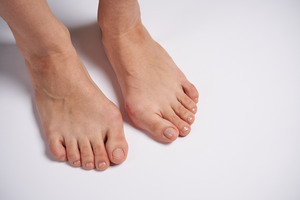Treatment for bunions aims to relieve pain, improve comfort, slow progression, and maintain function. The approach depends on the severity of symptoms and deformity.
Non-Surgical Treatments
Conservative management is typically the first line of treatment and can be effective for many individuals:
- Footwear Modifications: Switching to shoes with a wide, deep toe box, soft materials, and avoiding high heels is crucial.
- Padding and Taping: Protective pads (e.g., gel or moleskin) can cushion the bunion from shoe pressure. Specific taping techniques may help temporarily improve alignment and reduce stress.
- Orthotic Devices: Custom-made orthotics prescribed by our podiatrists at Fine Podiatry Clinic can help control abnormal foot mechanics (like overpronation), redistribute pressure, potentially slow progression, and reduce pain associated with the bunion deformity.
- Activity Modification: Avoiding activities that aggravate bunion pain.
- Ice Therapy: Applying ice packs can help reduce acute pain and inflammation.
- Medications: Over-the-counter nonsteroidal anti-inflammatory drugs (NSAIDs) like ibuprofen may help manage pain and inflammation temporarily.
- Exercises: Specific stretching and strengthening exercises may be recommended to maintain joint mobility and foot strength, though they won’t correct the bony alignment.
Surgical Options
Surgery (bunionectomy) is considered when non-surgical treatments fail to provide adequate relief from pain that significantly impacts daily life, or when the deformity is severe and progressive. There are many different surgical procedures designed to realign the bones, ligaments, and tendons. The specific procedure chosen depends on the severity and type of deformity identified on X-rays and clinical examination. Surgery aims to correct the alignment, relieve pain, and improve function. Our podiatrists at Fine Podiatry Clinic may advise and discuss surgical referrals if conservative care is insufficient.





